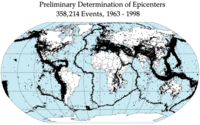
Photo from wikipedia
Examines the state in the field of earthquake prediction and modern views of geomechanics on the nucleation of foci of strong earthquakes. From the point of view of tectonophysics, the… Click to show full abstract
Examines the state in the field of earthquake prediction and modern views of geomechanics on the nucleation of foci of strong earthquakes. From the point of view of tectonophysics, the problem of the mechanism of mega-earthquake occurrence is considered. It is shown that data obtained by tectonophysics methods on the natural stress magnitudes in regions with the strongest twenty-first century earthquakes are the key to its solution. Results of tectonophysical stress inversion define the main area of the mega-earthquake focus as an extended area of low and medium magnitudes of stress. This result corresponds to geomechanical concepts indicating that the state of earthquake focus depends on the Rate and State theory of friction. Numerical geomechanical calculation shows that before the formation of a large-scale brittle fracture, the fault weakens, which manifests in the acceleration of aseismic slip. In real rock, the processes of strength reduction due to increasing aseismic displacement can take years, many decades, and perhaps even centuries. Tectonophysical analysis of natural stress shows that the nucleation of an earthquake can occur both from the boundary of the focus and inside of the focus. In both cases, this small area should be a zone of high stress.
Journal Title: Pure and Applied Geophysics
Year Published: 2019
Link to full text (if available)
Share on Social Media: Sign Up to like & get
recommendations!